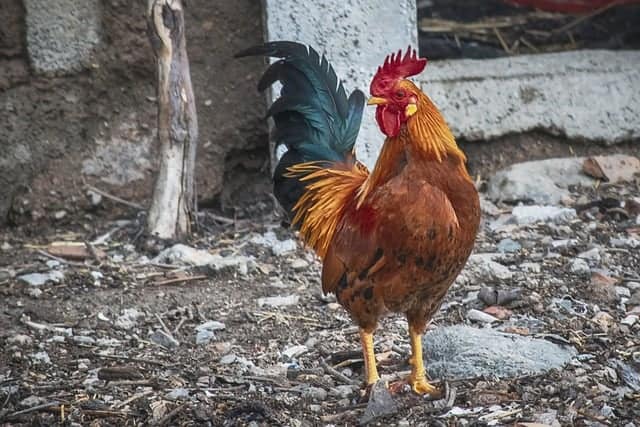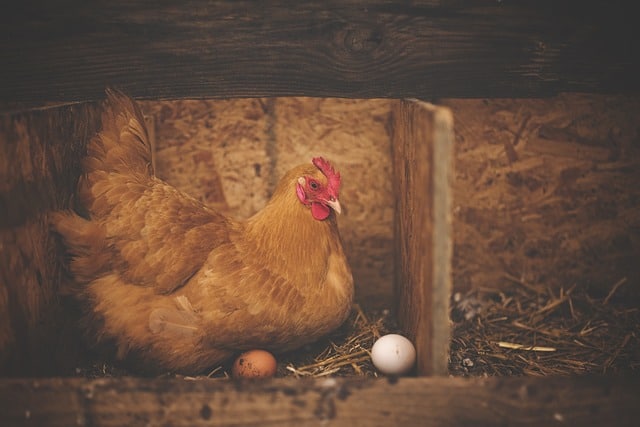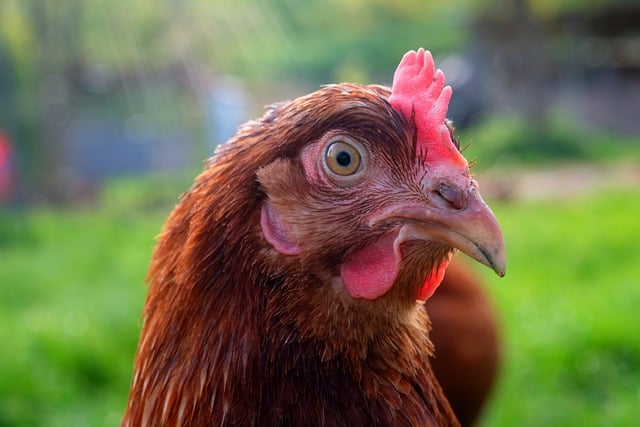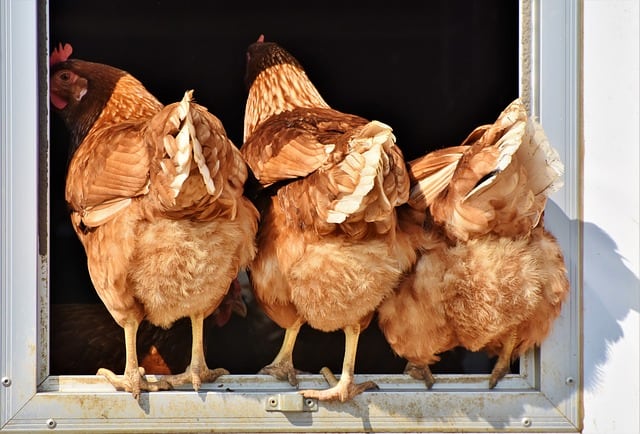The word ‘neuter’ or ‘neuterization’ is not commonly used with roosters. Used in the context of other species, the term means the removal or disabling of the testicles in male mammals to prevent reproduction and reduce certain hormonal behaviors.
In the case of roosters, the surgical procedure most similar to neutering in mammals is caponization.
Caponization involves removing the testes of a rooster, typically at a young age, to create a castrated bird called a capon.
Just like in humans and other mammals, surgical removal of the reproductive organs of the roosters can be quite dangerous. Therefore, it is important that a professional performs it.
In this post, we are going to look into this topic to answer the question – can I neuter my rooster?
Before concluding, we must first express the perceived benefits of this procedure and then later analyze the potential risks you could be putting your birds into.
Contents
Perceived Benefits of Rooster Neuterization
Improved Meat Quality
Capon meat is known for its tenderness, juiciness, and enhanced flavor compared to meat from intact roosters. Caponization results in the development of meat with more marbling and a finer texture, making it highly valued by some consumers.
Reduced Aggression
Male hormones, particularly testosterone, can contribute to aggressive behavior in roosters. By removing the testes, caponization is believed to reduce the levels of these hormones, resulting in a calmer and less aggressive bird. This can enhance handling and minimize the risk of injuries to both birds and humans.
Enhanced Growth
Caponization is thought to stimulate faster weight gain and better feed conversion efficiency compared to intact roosters. This may lead to improved profitability in commercial poultry production.
Reduced Sexual Behavior
Roosters, when left intact, exhibit mating behaviors such as crowing, mounting hens, and aggressive competition for mates. Caponization is believed to reduce or eliminate these sexual behaviors, which can be desirable in certain settings where reduced noise and aggression are priorities.
You need to note that the relevance and importance of caponization may vary depending on cultural, regional, and individual preferences.
Capons are not as commonly consumed or produced as they once were, and alternative methods, such as breeding for specific traits or using hormonal or pharmaceutical interventions, may be employed instead.
Additionally, caponization is a surgical procedure that requires expertise and is generally not performed by backyard poultry keepers or for pet roosters.
Also read: Are Chicken Dinosaurs?
The Potential Dangers of Neuterization
As we mentioned earlier, caponization, like any surgical procedure, carries certain risks and potential dangers. Here are some of the potential hazards associated with caponization:
Surgical Risks
Caponization involves a surgical procedure that requires expertise and precision. If performed incorrectly or by an inexperienced individual, there is a risk of complications such as excessive bleeding, infection, or damage to surrounding tissues.
Anesthesia
Caponization generally requires the use of anesthesia to ensure that the rooster remains unconscious and pain-free during the procedure.
However, anesthesia always carries some degree of risk, particularly for birds, as they have unique physiological characteristics that can make the process challenging. Improper administration or monitoring of anesthesia can lead to respiratory problems or even death.
Post-Surgical Complications
After caponization, roosters may experience post-operative complications such as pain, swelling, infection, or delayed healing. Careful post-operative management, including monitoring, wound care, and administration of appropriate medication, is crucial to minimize these risks.
Stress and Recovery
Caponization is a stressful experience for the rooster, and the recovery process can be demanding. The bird may require special care, including a controlled environment, isolation from other birds, and a modified diet to support healing and reduce the risk of complications.
Reduced Natural Behaviors
Caponization eliminates the rooster’s ability to exhibit natural mating behaviors, which may affect its overall well-being and social dynamics within a flock. It’s important to consider the potential impact on the rooster’s mental and social needs before proceeding with the procedure.
Given these risks and considerations, caponization is typically performed by experienced professionals in commercial poultry production rather than by individual backyard poultry keepers or for pet roosters.
If you are considering caponization for your rooster, it is crucial to consult with a veterinarian who specializes in poultry health to assess the feasibility and potential dangers specific to your situation
How Do You Neuter Your Rooster?
From the onset, we referred to the danger associated with neuterization of roosters mainly because it is an invasive surgical procedure that can have not so favorable prognosis.
You need to understand the anatomy (structure) and physiology (function) of the rooster’s body, including the exact location of the reproductive organs.
Bordering on the edge of caution, here are the steps you can follow (if you have professional veterinary training, proper surgical techniques and necessary experience) to neuter your rooster.
Below is a general overview of the process, but please keep in mind that it is not a comprehensive guide, and performing caponization without proper training is strongly discouraged:
Step 1: Preparation
Gather all the necessary equipment and supplies, including surgical instruments, disinfectants, sutures, and anesthesia if applicable. Ensure that the workspace is clean and well-organized.
Step 2: Anesthesia
Administer a local anesthetic to the rooster to minimize pain during the procedure. The specific anesthesia method and dosage may vary, so consulting with a veterinarian or poultry expert is crucial.
Step 3: Restraint
Securely restrain the rooster to prevent excessive movement during the procedure. This can be done by placing the bird in a specifically designed restraining device or by having an assistant hold the rooster gently but firmly.
Step 4: Incision
Make a small incision through the skin in the lower abdominal area, just above the testes. Carefully locate and expose the testes. The size and position of the testes can vary depending on the age and breed of the rooster.
Step 5: Removal of Testes
Gently remove each testis by carefully severing the connective tissues and blood vessels that attach them to the body. Take care to minimize bleeding and handle the tissues with cleanliness and precision.
Step 6: Wound Closure
Close the incision using appropriate sutures or wound closure techniques to promote healing. Proper wound closure helps minimize the risk of infection and ensures a clean recovery.
Also read: Fact or Fiction: Do Chickens Really Lay 2 Eggs a Day?
What Is the Best Time to Neuter Your Rooster?
is typically performed when the rooster is young, usually between 6 and 12 weeks of age. At this stage, the rooster’s testes have not fully developed, making the procedure relatively easier and less invasive.
Performing caponization at a younger age allows for a smoother surgical process and a better chance of behavioral modification. Younger roosters also tend to recover more quickly from the procedure compared to older ones.
It is important to consult with a veterinarian or an experienced poultry professional to determine the optimal age for neutering based on the specific breed, health condition, and individual development of the rooster.
Ethical Considerations
Rooster caponization raises several ethical considerations due to the invasive nature of the procedure and its impact on the welfare and autonomy of the birds. Here are some key ethical concerns associated with rooster caponization:
Pain and Suffering
Caponization or neuterization involve surgical castration, which causes pain and discomfort to the roosters. Even with the administration of local anesthesia, the procedure can still result in post-operative pain during the recovery period. Inflicting unnecessary pain on animals raises ethical concerns about their welfare.
Restriction of Natural Behaviors
Rooster caponization prevents roosters from expressing their natural behaviors, such as mating, reproduction, and establishing social hierarchies. This can be seen as a limitation on their autonomy and natural instincts, which raises ethical questions about the impact on their overall well-being.
Loss of Reproductive Capacity
Caponization permanently removes the rooster’s ability to reproduce. Some argue that denying animals the opportunity to engage in natural reproductive behaviors infringes upon their intrinsic value as living beings and restricts their right to experience a full range of biological functions.
Genetic Diversity
Caponization typically focuses on specific breeds or lines of roosters that are selected for certain characteristics. This can lead to a reduction in genetic diversity within the population, which may have long-term implications for the overall health and resilience of the breed.
Alternative Management Options
In some cases, alternative management practices can be implemented to address concerns associated with rooster aggression or other behavioral issues. Providing appropriate housing, environmental enrichment, or separating aggressive roosters from other birds can be explored as more humane alternatives.
Consumer Preferences and Transparency
Some consumers may have ethical concerns about consuming meat derived from caponized roosters. Providing transparency in labeling and ensuring that consumers are informed about the methods used in poultry production allows them to make informed choices aligned with their ethical values.
It is essential to carefully consider these ethical concerns and weigh them against any potential benefits when making decisions about rooster caponization or other practices that impact the welfare and autonomy of animals. Alternative approaches that prioritize animal welfare and allow for the expression of natural behaviors should be explored whenever possible.
Also read: Best Chicken Coop – Must-Read Reviews & Guide
Conclusion
Can I neuter my rooster? The answer is yes, you can. However, it is important to note that caponization is a complex surgical procedure and should not be attempted without proper training and experience.
If you are interested in caponization, it is recommended to seek guidance from a veterinarian, experienced poultry farmer, or other professionals who have expertise in performing the procedure safely and effectively. You also need to consider the ethical issues surrounding this procedure on the birds.




